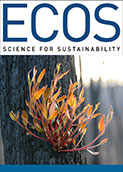
|
Published: 25 August 2014
Bitterns boom in rice bays
The largest population of Australasian Bitterns ever recorded has been found in Riverina rice crops, highlighting the potential role of rice growing – an industry often under fire for high water use – in waterbird conservation.
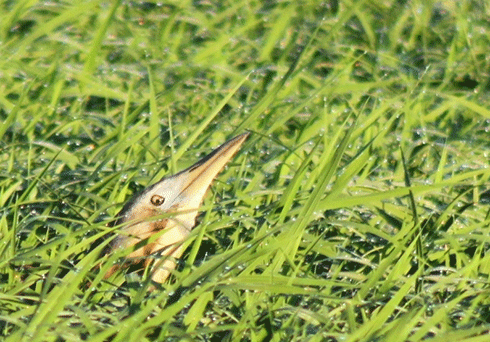
|
|
A bittern ‘freezing’ amid a rice crop at Colleambally. Credit: Matt Herring
|
Ecologist Matt Herring first heard the eerie boom of the Australasian Bittern (Botaurus poiciloptilus) calling out of rice fields in the Riverina (south-western New South Wales) about 15 years ago. He was intrigued.
The Australasian Bittern is a rare and elusive waterbird. Inhabiting shallow freshwater wetlands, it is wary of venturing out onto mudflats or in the open, preferring to lurk within, or on the edges of, wetland vegetation. Its reaction to intruders is to freeze and assume an erect posture – neck outstretched, bill pointing skyward. Sometimes it even sways with the breeze to enhance concealment.
But what the Bittern is most famous for is its characteristic basso call, which may explain the myth of the Bunyip – a fantastical creature said to live in creeks, swamps, billabongs, riverbeds and waterholes.
When Matt first heard that weird call, he thought ‘it was the odd Bittern here and there in the rice crops’.
But it turned out that rice farmers across the Riverina had also been hearing the Bittern’s call. In 2011, a curious grower took a photo and sent it off to BirdLife Australia for identification.
This sparked much interest – BirdLife Australia was at the time was campaigning to have the bird federally listed as endangered in Australia. It is now listed as such and is also listed as globally endangered on the IUCN Red List.
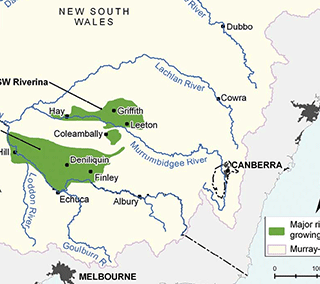
|
|
Map showing Riverina rice-growing areas (in green) in NSW. Credit: National Water Commission
|
BirdLife Australia joined forces with the Rice Growers’ Association of Australia to begin surveys, led by Matt, of Riverina rice fields for Australasian Bitterns during the 2012-13 growing season (September-October to January).
The study, covering 93 rice paddock study sites – 64 in the Murrumbidgee and 29 in the Murray – reached a preliminary estimate of 500–1000 Australasian Bitterns using Riverina rice crops during the growing season. Matt says it is the largest population of Bitterns ever recorded in Australia.
But no conclusive evidence of breeding was recorded until January 2014, when a nest with three chicks and two eggs was discovered. The confirmation of three other nests followed, leading Matt to conclude that the Bitterns are breeding successfully and that the Riverina population is sustainable.
‘If this is the case, then the rice fields of the Riverina represent a global stronghold for this endangered species,’ he says.
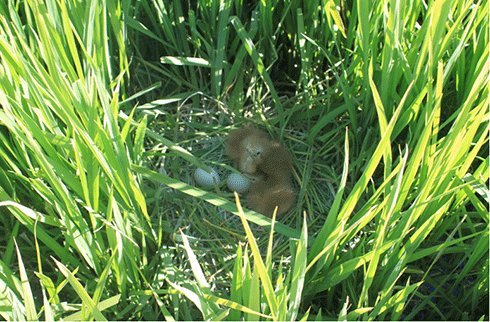
|
|
Bittern chicks and eggs on a nest hidden in rice. Credit: Matt Herring
|
In the Riverina rice is grown in bays, which are flooded for the growing season and then drained. When water allocations are 100 per cent, 100,000 hectares of rice are sown annually in the region. In this naturally dryland environment, the flooded rice fields become ephemeral wetlands, providing valuable habitat for a range of species adapted to such environments.
Dr David Freudenberger, formerly of CSIRO, now teaching at the Australian National University, co-authored a report on biodiversity in rice for the Rice Growers’ Association.
‘Australia has a long evolutionary history of ephemeral wetlands,’ explains David. ‘So the flooded rice bays are an environment that the whole food chain responds to rapidly, including a wide range of native species.’
Native species that thrive in rice include hundreds of species of native insects, such as dragonflies and midges. This insect population serves as a food source for a wide range of higher-order species, such as the endangered Australian Painted Snipe, the Southern Bell Frog, and the Eastern Long-Necked Turtle.
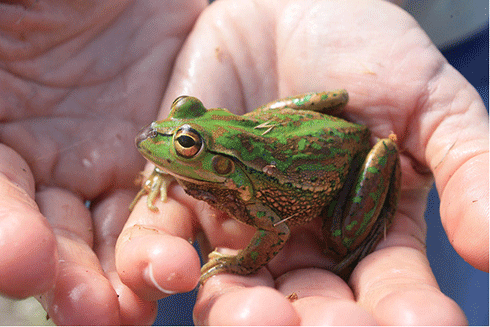
|
|
The endangered Southern Bell Frog Credit: Callie Nickolai under CC BY-NC 2.0
|
In association with the Rice Growers Association, Matt has developed a series of Bittern-friendly rice-growing tips. It turns out that additional structural elements in rice fields – such as the native Bull Rush (various Typha species), which tends to emerge in toe furrows around the edges of rice fields – are beneficial, as Bitterns often roost and feed in these areas. Bull Rush, otherwise known as Cumbungi, is considered a weed in rice farms, growing very fast over the growing season and reaching up to two metres in height by Christmas.
‘There are multiple biodiversity benefits, such as [attracting] reed warblers and crakes, from having additional structure in the crop,’ says Mr Herring.
‘What we’re recommending is sympathetic management of Cumbungi. We’ve already had some landholders who’ve put off spraying it, or tried to avoid spraying it in certain bays.’
The way in which crops are sown can also make a difference. Matt found that Bitterns have a strong preference for rice crops sown aerially – a method whereby seeds are dropped into flooded bays by aircraft – over crops seeded directly into dry soil by tractor-drawn machinery.
‘Aerially sown crops are inundated earlier than drill-sown crops,’ he says. ‘So we think the frogs and other prey are breeding up and there in good numbers when the Bitterns start to breed.’
According to Neil Bull of the Australian Rice Growers Association, around 60–70 per cent of rice in the Riverina is sown aerially. Over the past decade or so there, however, has been an increasing area drill-sown, as the latter uses less water reducing the population of ducks – which consume growing rice plants – in the cropped area.
As a crop with a high water demand, rice-growing in Australia is a highly regulated industry. And Australian rice farmers are among the most water-efficient in the world.
‘In terms of water use per tonne of rice it’s amazing,’ says Neil. ‘Due to the adoption of innovative practices, the industry average yield is now 11 tonnes per hectare, up from 9 tonnes in recent years.’
In acknowledging these tradeoffs, Dr Freudenberger talks of a ‘fair go landscape’, pointing out that a heterogeneity of wetlands – shallow and deep, ephemeral and permanent – are required for maximum biodiversity gains.
‘You change land management and some species benefit, but not others,’ he continues.
‘How do we manage our land use practices to allow for those species doing it tough? There are some native species that absolutely thrive in shallow-water, ephemeral wetlands provided by rice bays. But we also need to pay attention to the landscape-scale by looking after patches of native woodlands, grasslands and shrublands that are home to a diversity of creatures that can’t call a rice bay home.’
Around the Riverina, these native habitats include Black Box (Eucalyptus largiflorens) woodlands that need to be inundated with shallow water from time to time. These woodlands are important places for many native birds and often act as wildlife refuges when the rice bay is fallow or sown to wheat over winter.
Neil Bull is optimistic about the implications of the Bittern study. ‘I’ve always argued that if we can manage 10 per cent of our rice area for this endangered bird, then we’ve got 10,000 hectares of wetland habitat.
‘A lot of our growers really love this project. It sort of sells itself. People come on board because they want to be involved. And while they’re involved, they come up with all sorts of management tweaks that contribute to biodiversity.’


